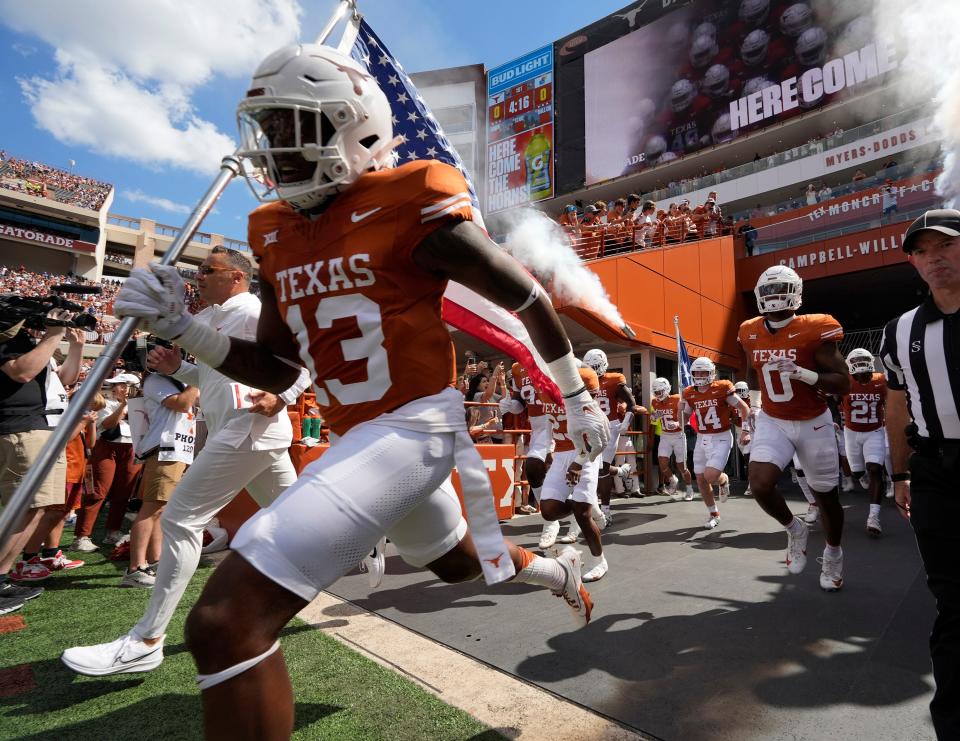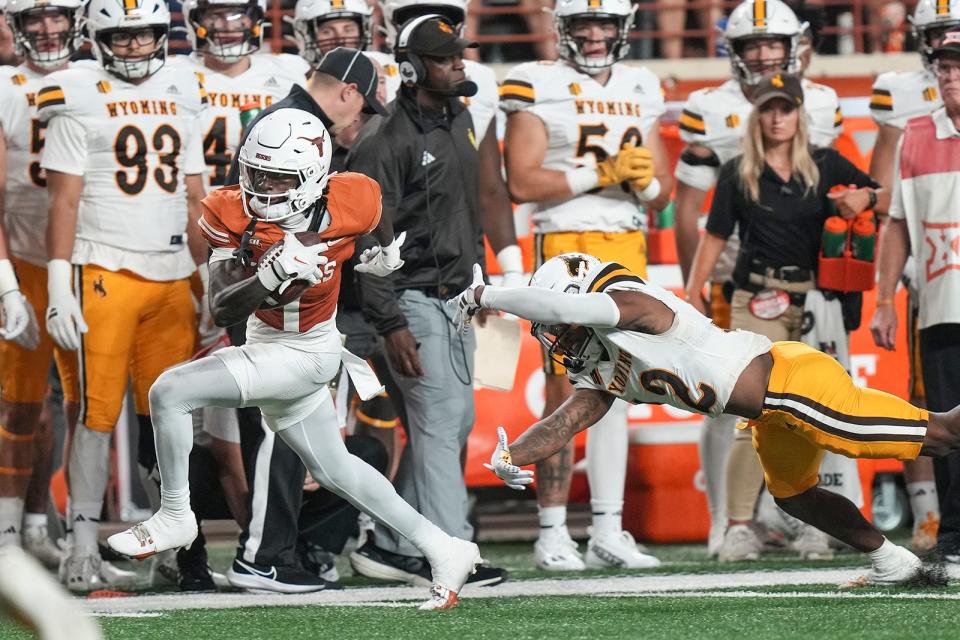Texas Longhorns football team will join SEC crowd when it replaces turf with grass in DKR
Despite injury concerns by players and aesthetic worries from administrators, college athletic departments have increased the use of artificial turf in football stadiums over the past two decades.
But Texas will do its part to reverse that trend when it opens its new athletic practice facilities within the next few years and reintroduces grass into Royal-Memorial Stadium. When it does, Texas will join most of its peers in the SEC, which is the most grass-friendly conference in the country.
“I just love football played on grass,” Texas athletic director Chris Del Conte told the American-Statesman this past week. “It’s as Americana as apple pie. I just think grass is where football is meant to be played.”
More: UT announces plans for new football practice facility
Del Conte hopes to have grass inside DKR by the 2026 season, but the timing correlates with the construction of new practice fields just south of the school’s Moncrief-Neuhaus Athletic Center. When Texas does plant its new grass, it will join the crowd in the SEC. Of the 14 schools in the conference, 12 play their home games on grass. Only Missouri and Kentucky play on artificial turf.
That number stands in stark contrast with the rest of the country. According to research compiled by The Associated Press, 73% of the 133 schools that currently compete in the top tier of NCAA football play their home games on a synthetic surface. The Big 12, which Texas and Oklahoma will leave following this season to join the SEC, has just five teams that play on grass: TCU, Central Florida, Iowa State, BYU and Oklahoma.
Twenty years ago, 58% of Division I schools — that top tier of collegiate football — played on grass.
More: Big 12 football power poll: For first time in 2023, Oklahoma supplants Texas atop rankings

Turf ‘a grind on the body’ for football players
Lingering concerns about turf have again flared in the NFL following a recent spate of injuries that players associate with an artificial playing surface.
After New York Jets quarterback Aaron Rodgers ruptured an Achilles tendon on the artificial turf at MetLife Stadium in New Jersey earlier this season, NFL Players Association executive director Lloyd Howell called on owners to convert all NFL stadiums to a natural surface. Kansas City Chiefs tight end Travis Kelce blamed his recent sprained ankle on artificial turf that “grabbed” his cleat.
"If you watch the slow motion, my ankle kind of slips for a couple of inches and then it finally grabs on the turf,” Kelce said on a recent podcast hosted by his brother, Jason Kelce, the starting center for the Philadelphia Eagles. “That's been the knock (on turf among players), is that when you do slip, you don't just slip right through the grass."
Jason Kelce followed his brother by exclaiming that NFL owners “should get rid of turf altogether.”
More: Plenty of injured Longhorns on the mend as No. 9 Texas enters its bye week
According to the AP, some studies — including one using NCAA injury surveillance data from 2004-14 — have concluded that playing football on artificial surfaces increases the frequency of certain lower body injuries. Experts, though, are hesitant to draw definitive conclusions.
“The preliminary studies have shown that there is an increase in injury risk to the lower extremity on synthetic surfaces vs. grass,” Bud Cooper, clinical professor in the department of kinesiology at the University of Georgia, told the AP. “Now, is that the Bible? It is not.”
More: Bohls: Texas' C game with moments of brilliance wasn't enough to get past Oklahoma
While Texas’ players haven’t addressed specific injuries, they almost all welcome the arrival of grass in Royal-Memorial Stadium, even if most athletes on the current roster will no longer be wearing burnt orange. The wear and tear on the body, especially the lower legs, is noticeable after playing a game on grass compared to an artificial surface, multiple players said.
“I like grass better, how it feels,” right tackle Christian Jones said. “It just feels better on the joints, especially the next day. You’re not as sore that next day (after a game). And when you fall, it doesn't hurt as much. And no turf burns. Yeah, I definitely prefer grass.”
A speedster like receiver Xavier Worthy also prefers grass, even if an artificial surface enhances his ability to accelerate in and out of cuts.
“Grass is really just less stress on your legs,” Worthy said. “With turf, there’s more stress and it’s kind of a hard grind on the body. And you can kind of feel definitely getting cut up more on turf.”
Of course, some players say they don’t even think about the surface during a game.
“Football’s football,” said defensive back Jahdae Barron. “Shoot, we used to play in the street and on rocks when I was little.”
More: Can Texas football reach the Big 12 title game and the playoff? Chances good with wins.

Del Conte says grass in DKR coming soon
Soon, there won’t be many future Longhorns playing on artificial turf, let alone rocks and asphalt.
Del Conte, a longtime proponent of playing games on grass, understands that Texas can’t install that natural surface until the team has a closer practice location than Denius Fields, which is between Red River Street and the frontage road of Interstate 35.
More than any other Texas football coach over the past 15 years, Steve Sarkisian likes to practice inside DKR because of the time management convenience. That means no grass since that surface can’t retain its playing shape while enduring multiple practices.
The new athletic practice fields will be located on the university tract that currently holds the Steve Hicks School of Social Work at 1925 San Jacinto Blvd., between the Recreational Sports Center and the Jamail Texas Swimming Center. According to Del Conte, the university will begin demolition of the buildings on that site this summer. If construction follows the tentative schedule, the new facility will be completed for the 2026 season and natural grass will be back inside DKR.
Royal-Memorial Stadium had natural grass from 1925 through 1968. The Longhorns spent almost 30 years playing on artificial turf before the school installed natural grass in 1996. Texas played on natural grass from 1996 to 2009.
Turf provides a cheaper option for a school than grass, even though the upfront cost of installing an artificial surface can exceed $1 million, which often doubles the cost of planting grass. But according to industry studies, the maintenance of a grass fields exceeds the cost of installation within a few years.
But the price tag for the real stuff shouldn’t stop a school like Texas from installing grass, Del Conte said.
“If you're the northern region, I understand the synthetic surface,” Del Conte said. “It’s harder to grow grass and keep it maintained with the amount of wear and tear you have on it. But the region we're in, we should play on grass.”
This article originally appeared on Austin American-Statesman: Texas football players, AD looking forward to eventual grass in DKR

